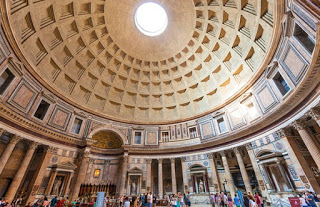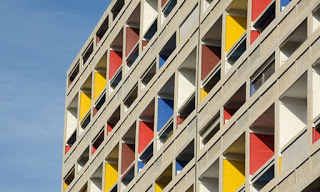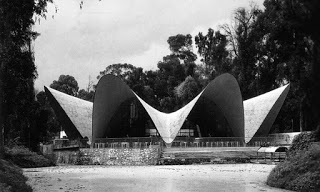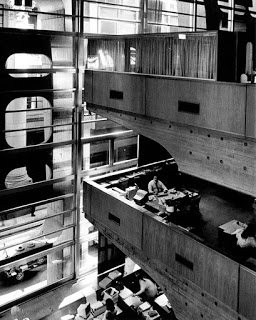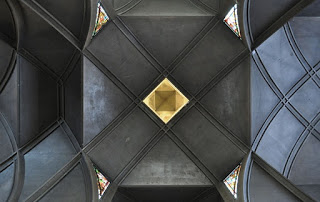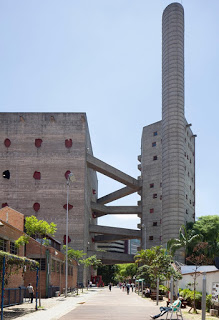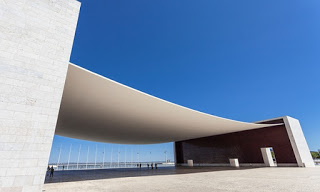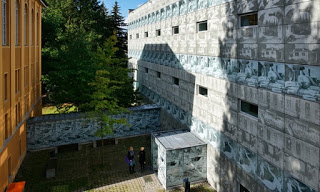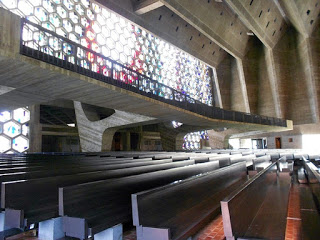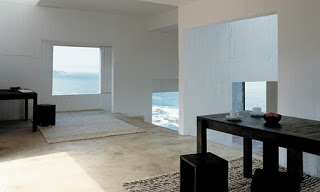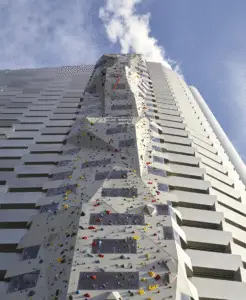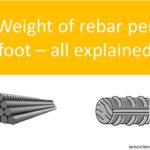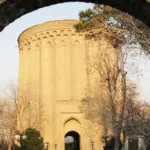1 | Pantheon, Rome
possibly by Apollodorus of Damascus, c126 AD
The ancient Romans didn’t have reinforced concrete (that is, strengthened with steel) but they had concrete, and used it to such heart-stopping effect on the Pantheon that no one has really been able to match it since. The true moment of genius is the way in which, after a certain amount of harrumphing with Corinthian columns and marble decoration at its lower levels, the design resolves itself into the pure circular oculus at its top, unglazed, which causes a beam of light to rake around the interior like an internalised sun.
2 | Unité d’Habitation, Marseille
Le Corbusier, 1952
Concrete has the ability to be primitive and technological, massive and levitating, to combine the properties of steel with those of mud. Le Corbusier knew how to run the gamut of its expressive range better than anyone. He used it as the medium for translating his fascinations both with aeroplanes and other modern machines and with ancient landscapes and temples. His Unité d’Habitation, a massive apartment building in Marseille, is both a liner floated to its site from the nearby Mediterranean and a chunk of the surrounding mountains, rectangularised, ark and Ararat at once.
3 | Los Manantiales restaurant, Mexico City
Félix Candela, 1958
Many architects and engineers have exploited the ability of reinforced concrete to produce structures of exceptional apparent lightness which, despite being made of a form of masonry, hardly seem to touch the ground. Quite a few have used arches and vaults in the form of parabolas, which direct the structural forces inside the material with particular efficiency, which makes the structure lighter still. Félix Candela was one of the earliest and best to pursue these ideas. The anti-gravity effects of the Los Manantiales restaurant were particularly magical.
4 | Bank of London and South America, Buenos Aires
Clorindo Testa, 1966
The Italian-Argentinian architect Clorindo Testa wasn’t particularly interested in getting concrete to look light, at least from the outside, instead heaving it out of the ground into an extraordinary structure that has something of a dinosaur’s skeleton. Yet it still manages to achieve a civilised rapport with the neo-classical facades around it. It also forms a perforated carapace that filters sunlight to the interior and creates both enclosure and openness. It unexpectedly ends up having some of the qualities of a Japanese screen, if with considerable added tonnage.
5 | Saint-Jean-de-Montmartre, Paris
Anatole de Baudot, 1904 (interior)
A slightly gauche attempt to realise the principles of gothic architecture in reinforced concrete but at the same time endearing and heroic. The church was sufficiently ahead of its time that building codes hadn’t caught up, which meant construction had to be delayed while a demolition order was removed. De Baudot didn’t quite work out that you can achieve gothic lightness of construction without gothic details such as pointed arches and vaults. Auguste Perret would later do this with the radiant Notre Dame du Raincy, but Saint-Jean-de-Montmartre makes the list by virtue of being a pioneer.
6 | SESC Pompéia, São Paulo
Lina Bo Bardi, 1986 (sports towers)
A swimming pool, indoor football pitches and other sports courts are stacked up in the fattest of this group of three towers; changing rooms are in another, linked by dynamic bridges, which transforms the normally humdrum movement from cubicle to playing zone into urban theatre. The third, cylindrical, tower stores water. Knowing that a change of political wind could blow away socially minded projects like this, Bo Bardi made it fortress-like: a citadel of liberty, it was called. The window openings, which seem punched out by a caveman, are amazing.
7 | Portuguese National Pavilion, Expo 98, Lisbon
Álvaro Siza 1998
Álvaro Siza is one of the less declamatory and more subtle contemporary architects, which makes this moment of theatre all the more striking. He takes a sheet of concrete and drops it like a pocket handkerchief between two rectangular blocks. The special properties of reinforced concrete, in particular its abilities to hang as well as vault, and achieve high strengths with minimal thickness, are used to the full. A classic of making design look effortless, when the engineering and construction that goes into it is anything but.
8 | Eberswalde technical school library, Germany
Herzog and de Meuron, 1999
By the 1990s it might have been thought that the list of Things to Do With Concrete had been exhausted. Herzog and de Meuron, however, came up with something new, which was to print an eclectic set of images, selected by the artist Thomas Ruff, on to the material. The same images were also printed on horizontal bands of glass, set flush with the concrete, which by day gives the library’s simple oblong shape an apparently homogeneous surface. By night the transparent parts light up and the solid parts don’t, which creates an opposite impression.
Like Us on Facebook!
9 | St John’s Abbey Church, Collegeville, Minnesota
Marcel Breuer, 1961
A rare error in the smooth-running 10 best machine allows a late entry, a church by the Bauhaus alumnus Marcel Breuer deep in the midwest that makes many tonnes of concrete into mineral origami. I am indebted to a reader, Rolf Erikson, for pointing this project out. Fans of Louis Kahn clamouring for his inclusion won’t be pleased, though. Kahn was indeed magnificent and it was a tough call to leave him out. But the Breuer is more concrete-y.
Subscribe Us on YouTube!
10 | Poli House (interior), Coliumo, Chile
Pezo von Ellrichshausen, 2005
Apologies to Tadao Ando, Denys Lasdun, Robert Maillart, Oscar Niemeyer, Zaha Hadid, Rachel Whiteread, Pier Luigi Nervi, Frank Lloyd Wright, and Sverre Fehn, all of them magicians with concrete who deserve a place in a top 10. But the last slot goes to a house on a promontory where difficulties of access limited niceties in construction. The result is a structure whose cubic purity is offset by roughness in its substance, and where the traces of the timber moulds of its concrete give it the feeling of an unusually exalted wooden shack.

